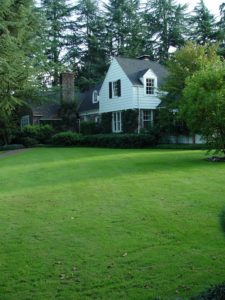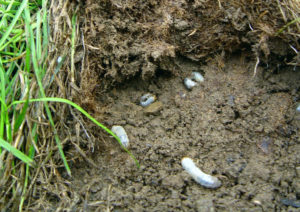Are Lawns Horrible?
October 5th, 2021
I detect a growing sentiment – apparently a corollary to the native-plant and save-the-pollinators movements – that we all should stop growing lawns.

Is this evil incarnate?
It seems to go beyond just shrinking lawn space in favor of something more useful into a belief that lawns are downright evil.
I’ve gleaned smatterings of that the past couple of years and heard opinions to that effect in a class I taught on lawn alternatives for Phipps Conservatory last summer.
What nailed it down was an email I got from a reader (following a lawn-care post) that bluntly said, “Don’t you know that lawns are horrible? They are a desert for insects and thus birds. Plant a meadow.”
So are lawns ecological wastelands that we all should get rid of as soon as possible? Are lawns really “horrible?”
While I’m far from a lawn fanatic, my view is that like any other plant, turfgrass has its pros and cons as well as legitimate uses in our landscapes.
I agree that meadows, native-plant gardens, and generally more diverse plantings are better at “servicing” the ecosystem.
I agree that lawns cover an inordinate amount of our yard space, mainly because they’re cheap and easy to install, familiar to people, and ideal for foot-traffic uses, such as kids’ play space, entertaining, and pet runs. Turfgrass is basically our default plant choice.
And I agree that lawns are a key source of water pollution, given all of the fertilizer, crabgrass preventers, grub controls, insecticides, and fungicides that some people use to achieve their green carpets.
But horrible? An ecologic desert? I think that’s taking it a bit too far.
For one thing, lawns aren’t barren of life.
Unless you’ve somehow managed to kill everything with chemicals, turf soil is teeming with fungi, nematodes, bacteria, and other microbes. You can’t see them, but they’re an important part of breaking down organic matter and feeding life higher on the food chain.

Beetle grubs love turfgrass, and skunks and birds love feeding on them.
Turfgrass is also the preferred home of beetle grubs, armyworms, and sod webworms (among others). Add those to earthworms, ground-nesting bees, ants, cicadas, crickets, billbugs, cutworms, grasshoppers, spittlebugs, and chinch bugs, and the lawn can be a near buffet for native skunks, moles, raccoons, frogs, and especially birds – the creatures supposedly left out in the cold by lawns.
Yes, we consider many of the above “pests,” but they all play a role in our ecosystems. It seems to me that if the reason we’re dissing lawns is because they’re not healthy for the ecosystem, we should be honoring the whole ecosystem – not picking our own preferred winners and losers (i.e. birds and butterflies are good, Japanese beetles and ants are bad).
If you think about it, what food does a bird like better than a mass of cicadas? I’ve seen lots of birds pecking in my lawn for worms and grubs.
My point isn’t to defend lawns… just to dispel the untruth that lawns are barren wastelands that offer no value to our ecosystem.
A second point is that lawns don’t have to be pesticide dumps. And most of them aren’t.
From what I see, the majority of lawn-owners aren’t interested in spending the time, money, or effort putting down all sorts of products any more than they want to finance and care for the gardens that would replace some of their lawn space.

Most people are fine with an “OK lawn” that they just mow.
Most just mow and accept that their green out front is going to be a blend of grass and assorted short weeds.
It’s really only a minority of people shooting for that green carpet by applying everything they can get their hands on – or hiring a company to do it for them.
Read George’s post on caring for lawns the “green-carpet way” vs. the “OK way.”
Personally, I don’t think a green carpet is the way to go. But I also don’t think that gives me the right to judge green-carpet people as doing something “horrible” or “evil,” making them feel guilty because they grow a lawn instead of a meadow.
The story that keeps coming back to me is the day I was helping a kindly, elderly woman figure out how to redo her landscape.
When we got to a band of peonies, the woman asked, “Do I have to take these out?”
“Why? Are they diseased or something?” I asked.
“No,” the woman said. “My mother gave them to me, and I like them. But I heard peonies aren’t natives and that we shouldn’t be growing non-natives.”
I told the woman to keep her precious gift – native or not – and to remember her mother every time she saw the peonies bloom.
As for meadows, they are useful to wildlife and relatively low-care, but they aren’t the end-all answer to our yard space either.

Some people like this look. Others not so much.
Meadows are a lot of work and expense to install, they need weeding at least in the early going, they’re not very attractive in winter, they take three good years to hit full stride, and they require ongoing mowing to prevent woody weeds from taking hold.
Then there’s the down side that few meadow proponents mention – ticks. Lyme-disease-carrying ticks prefer the tall, hands-off growth of meadow plants to mowed lawns.
I got a first-hand taste of that several years ago when I interviewed a fellow with several acres of meadows. He told me he got Lyme disease from a tick bite and from then on didn’t go into his meadows without wearing long pants, tucking his pants legs into his socks, spraying down with bug repellent, and doing a thorough tick check afterward.
It was the first garden tour I did that felt more like a haz-mat-and-decontamination procedure.
Again, I’m not trying to champion lawns or discourage meadows… just pointing out that lawn alternatives also have their pros and cons.
I understand and accept that meadows aren’t for everyone and that some people don’t have the money or energy to tear out a lawn and put in gardens or meadows.
I understand that some people might not be able to manage more outdoor effort than taking a weekly trip on the riding mower.
I understand that some people are deathly allergic to the bees that meadows would bring or have severe allergies to wildflower pollen.
I even understand that some people just like the look of a thick, dark-green, weed-free lawn. After all, it’s their property.
Those are all valid reasons – just as valid as the reasons of people who believe we should do more to help pollinators and plant more native plants.
In other words, one size doesn’t fit all.
I think there’s room in our landscapes for all kinds of uses and plants. And we each should get to decide what’s best for our own situation – free from any finger-wagging from disagreeing others.
Read George’s post on how to shrink and replace a lawn
Read George’s PennLive.com article on four ways to convert lawns to something else







